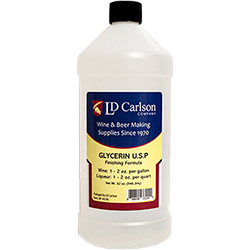Vegetable Glycerine Can Be Used for More than Just Filling Your Airlocks
Posted by Matteo Lahm on 11th Jul 2023
Alright, home brewers and winemakers, let's take a deeper dive into the world of vegetable glycerine. Now that you're acquainted with its role as a steadfast airlock filler, it's time to explore its other uses in your brewing process and understand what it really is.
Vegetable glycerine, also known as glycerol, is a clear, odorless liquid derived from plant oils, typically palm, soy, or coconut oil. It's produced using a method called hydrolysis, where these oils are heated under pressure with water, causing the glycerine to split away from the fatty acids and mix with the water, forming a syrup-like consistency. It's a natural humectant, meaning it attracts moisture, which is why it's often used in skincare products. But its uses extend far beyond just cosmetics.

In the commercial brewing world, vegetable glycerine is more commonly used in beer production, particularly in darker, heavier beers such as stouts and porters. These beers have a naturally robust and complex flavor profile, and the addition of vegetable glycerine can enhance the body and mouthfeel, making the beer feel more substantial on the palate. It's like adding a thick, plush rug to a bare hardwood floor; it adds depth and richness. A dosage of about 1% of your total volume can significantly enhance the body and mouthfeel of your homemade beer.
Vegetable glycerine can also provide a subtle sweetness, which can balance out the bitterness in these darker beers. But remember, moderation is key. A dosage of 0.5% to 1% of your total volume should do the trick.
In the world of wine, vegetable glycerine is often used in dessert wines and fortified wines like Port and Sherry. These wines naturally have a higher sugar content, and the addition of vegetable glycerine enhances the sweetness and contributes to a fuller, richer mouthfeel. It's like adding a dollop of cream to your coffee; it rounds out the flavor and gives it a smoother finish.
However, when it comes to dry wines, the use of vegetable glycerine must be done sparingly. Dry wines are characterized by their lack of residual sugar, and the addition of vegetable glycerine can add a slight sweetness. But when used in the right amount, it won't necessarily make the wine sweet but can enhance the body and mouthfeel of the wine, giving it a fuller, rounder texture.
Lastly, vegetable glycerine acts as a preservative in both beer and wine, keeping your brew fresh for a longer period. It's like a fountain of youth for your brew. A dosage of 0.5% to 1.5% of your total volume can help extend the shelf life of your homemade beer or wine.
So, there you have it. Vegetable glycerine: an unsung hero of home brewing and winemaking. It's like a multi-tool for your brew, enhancing everything from texture to sweetness to longevity. So, the next time you're brewing a batch, remember to add a dash of vegetable glycerine. Your palate will be grateful.

